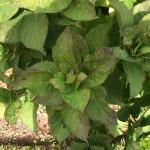Chilli Thrips
Pest: Chilli Thrips*, Scirtothrips dorsalis
Order: Thysanoptera
Family: Thripidae
* The word 'thrips' is both singular and plural.
Introduction
The non-native, exotic chilli thrips (Scirtothrips dorsalis) has been recently confirmed from two samples of damaged Hydrangea spp. foliage submitted to the UMass Plant Diagnostics Laboratory from Barnstable County. Through the multi-agency coordinated efforts of Dr. Lance Osborne and Dr. Vivek Kumar of the University of Florida, Dr. Cindy McKenzie with the USDA-ARS, Thomas Skarlinsky, USDA- APHIS, Thysanoptera Specialist- Eastern US, Russell Norton, Extension Educator with Cape Cod Cooperative Extension, Tawny Simisky, Entomology Specialist with UMass Extension, and USDA-APHIS PPQ National Identification Services, this serious pest known to attack several horticultural crops grown in the US has been confirmed in Massachusetts for the first time. Previously considered to be a single species, chilli thrips is now confirmed as a cryptic species complex of at least 9 different species out of which two (referred to as South Asia 1 and East Asia 1) are found in the US. In the current assessment, East Asia 1 has been detected in Massachusetts.
Hosts/Range
Chilli thrips has been a significant global pest of economically important ornamental, vegetable, and fruit crops in Southern and Eastern Asia, Oceania, and parts of Africa. After its US invasion into the United States in 2005, populations of chilli thrips have been detected in the US in areas of Florida, Texas, Alabama, Louisiana, Georgia, and New York (Kumar et al., 2013). According to the literature, the potential geographic distribution of this insect in North America extends from southern Florida to the Canadian border, Puerto Rico, and the Caribbean.
It is reportedly a pest of over 100 host plants belonging to over 40 plant families, although it may actually feed on over 225 plant taxa in 72 different plant families worldwide; however, it may not be capable of reproducing on all of those potential hosts. While the potential host plant list for the chilli thrips is extremely long, records of infestations on certain host plants seem to vary with geographic location. It is important to note that chilli thrips has currently only been detected on Hydrangea macrophylla in Barnstable County from two residential landscapes. This insect has not been confirmed on any other host plants in any other locations in Massachusetts at this time. The history of these samples suggest that chilli thrips may be overwintering on H. macrophylla in the landscape in those two locations.
Other potential host species for this insect include, but are not limited to, pepper, strawberry, blueberry, cotton, rose, peanut, Japanese privet, Rhododendron spp., Viburnum spp., eggplant, grapes, melon, tobacco, and tomato.
Description/Life Cycle
The chilli thrips is an extremely small insect, and is < 2 mm. in length (5/64 of an inch) and therefore it is unlikely to be detected without magnification. It is a member of the insect order Thysanoptera to which approximately 8,000 species belong, 5,000 of which are well described including information about their life histories and habitats. Approximately only 1% of described thrips species are considered to be serious pests. They can reduce plant value through feeding, oviposition (egg laying), and disease transmission. Due to the small size and complexity of morphological identification of chilli thrips, a combination of molecular and morphological identification of this species can be important.
In general, the larvae of this insect are creamy-white to pale in color, 0.37 mm. to 0.71 mm. in size, and can be distinguished from other thrips larvae by the placement and number of hairs found on the head, pronotum (covering the dorsal surface of the thorax), legs, and abdomen along with other important morphological features that can only be seen with a microscope. The pupae of this insect range from 0.78 mm. to 0.80 mm. in size. Finally, the adults of this insect are pale yellow with dark brown ridges on the dorsal and ventral segments of the abdomen, they can be 1.5 mm. in length with dark wings, and the head is wider than it is long with 8-segmented antennae. Life stages for this insect include egg, 1st and 2nd instar larva, prepupa, pupa, and adult. Mating results in only partial fertilization of the female insect’s eggs, where unfertilized eggs become male chilli thrips and fertilized eggs become female chilli thrips.
Eggs are laid inside plant tissues (above the soil surface) and hatch between 5-8 days depending upon abiotic conditions. A female chilli thrips may lay 60-200 eggs in her lifetime. Larvae and adults gather near mid-veins or the borders of damaged leaf tissues. Pupae may be found in the soil, leaf-litter, curled leaves on the host plant, and areas of flowers and fruit. Larval instars develop in 8-10 days and pupation occurs in 2.6-3.3 days, again depending on abiotic conditions. The life span of the chilli thrips is also greatly influenced by temperature and the host plant it is developing on. There can be 8 generations of this insect per year in temperate climates and 18 generations per year in warm, subtropical and tropical climates. It is not yet known how many generations of chilli thrips could be present per year in Massachusetts, but in landscaped situations this should be limited by temperature. Seasonality of chilli thrips development in Massachusetts landscapes is also not yet fully understood; however, they are believed to be overwintering as the samples came from plants that have shown symptoms for several years in well-established landscapes. In Japan, egg laying begins in late-March or early-April and first generation adults are seen in early-May. Certain geographic locations in Japan, particularly in the North, have weather similar to that of New England.
Damage
Chilli thrips may be present in all above ground plant parts of its host plants. It may prefer young leaves and buds as well as tender plant stems. Thrips feed on their host plants with piercing-sucking mouthparts which repeatedly puncture plant tissues and can leave browned lines that eventually wrinkle and curl. The host plant meristem (growing tips of shoots), terminals, and other tender plant parts above the soil surface may be impacted. Chilli thrips feeding results in scarring, distortion of leaves, discoloration of buds, flowers, and young fruit on certain hosts. Damaged tissue may appear silvery to brown or black. Foliage may become discolored or disfigured and leaves may curl upward. Severe infestation can also lead to the death of the host. Brown streaks of frass (excrement) may be found on leaves or fruit. Premature leaf drop has also been documented, as well as the transmission of seven different plant viruses. However, no virus transmission due to chilli thrips feeding has been confirmed in MA or in any other parts of the US.
Damage from chilli thrips is easily confused with feeding damage from broad mites (Polyphagotarsonemus latus) on hydrangea. Therefore, identification based on damage to the host plant alone is not recommended.
Management
While the local distribution and extent of the chilli thrips invasion is not yet completely understood in Massachusetts, the best strategy for the management of this pest is currently continuous monitoring and accurate identification of thrips when they are detected. Proper identification of chilli thrips is essential for the success of management programs. Those in southeastern Massachusetts who are concerned about this insect should begin by monitoring for the chilli thrips on hydrangea. This insect can be observed with magnification on symptomatic plant material, or it can be detected using yellow, blue, white, or green sticky cards. Cards may need to be replaced every 7-10 days throughout the monitoring period.
Cultural management techniques are available for this pest. Removing weeds can help reduce a potential reservoir as some may act as hosts for the thrips or viruses. Removing dropped hydrangea leaves in the fall and disposing of them away from susceptible host plants may help reduce populations. Biological control is primarily available for application in nursery and greenhouse settings and certain commercially available biocontrol agents such as minute pirate bugs, predatory mites, and possibly lacewings, ladybird beetles, and predatory thrips can be used, however the efficacy of these biocontrols for chilli thrips may not be completely understood.
Chemical management should involve the rotation of active ingredients with different modes of action as resistance to organochlorines, organophosphates, and carbamates has been documented in chilli thrips populations. Cultural, mechanical, and biological control (in greenhouses) options should be utilized as much as possible. Sources suggest that active ingredients such as carbaryl and permethrin have been found to be effective in managing this pest, however they are damaging to natural enemy populations. Sources also suggest that insecticides consisting of the active ingredient imidacloprid as a soil drench or foliar application can provide several days of suppression following treatment; however, this active ingredient should not be applied to flowering host plants when in bloom due to the risks to pollinators. The active ingredient spinosad, derived from naturally occurring soil bacteria, may provide up to 15 days of suppression of the adults and larvae of chilli thrips when applied as a foliar application. Spinosad should also not be applied to host plants when in bloom as it is toxic to pollinators when it is still wet. Once it has dried (in a matter of hours depending on temperature and humidity), the risk to pollinators decreases. Spinosad is labelled for thrips in ornamental plants, among other uses. The active ingredient abamectin, a fermentation product of Streptomyces bacteria, has shown management of the adults and larva by foliar application for a period of 2 days. Avoid application to flowering plants, as abamectin is also highly toxic to bees. Beauveria bassiana is a naturally occurring, soil-dwelling fungus, which is also labelled for management of thrips on hydrangea. In greenhouses, it may provide 3-7 days of management of adult and larval chilli thrips when applied as a foliar application. Efficacy in ornamental landscape settings is not completely understood. B. bassiana is relatively non-toxic to beneficial insects, however applications to areas where bees are actively foraging should be avoided.
Sources:
Kumar et. al. 2016: “Thrips Management Program for Horticultural Crops” (http://edis.ifas.ufl.edu/pdffiles/IN/IN114500.pdf)
Kumar et. al. 2013: “An Overview of Chilli Thrips, Scirtothrips dorsalis (Thysanoptera: Thripidae) Biology, Distribution and Management”
Kumar et. al. 2009: “Chilli thrips Scirtothrips dorsalis Hood (Insecta: Thysanoptera: Thripidae)” (http://edis.ifas.ufl.edu/pdffiles/IN/IN83300.pdf)
Osborne LS. 2008. “Chilli thrips, Scirtothrips dorsalis Hood.” (http://mrec.ifas.ufl.edu/lso/thripslinks.htm)



